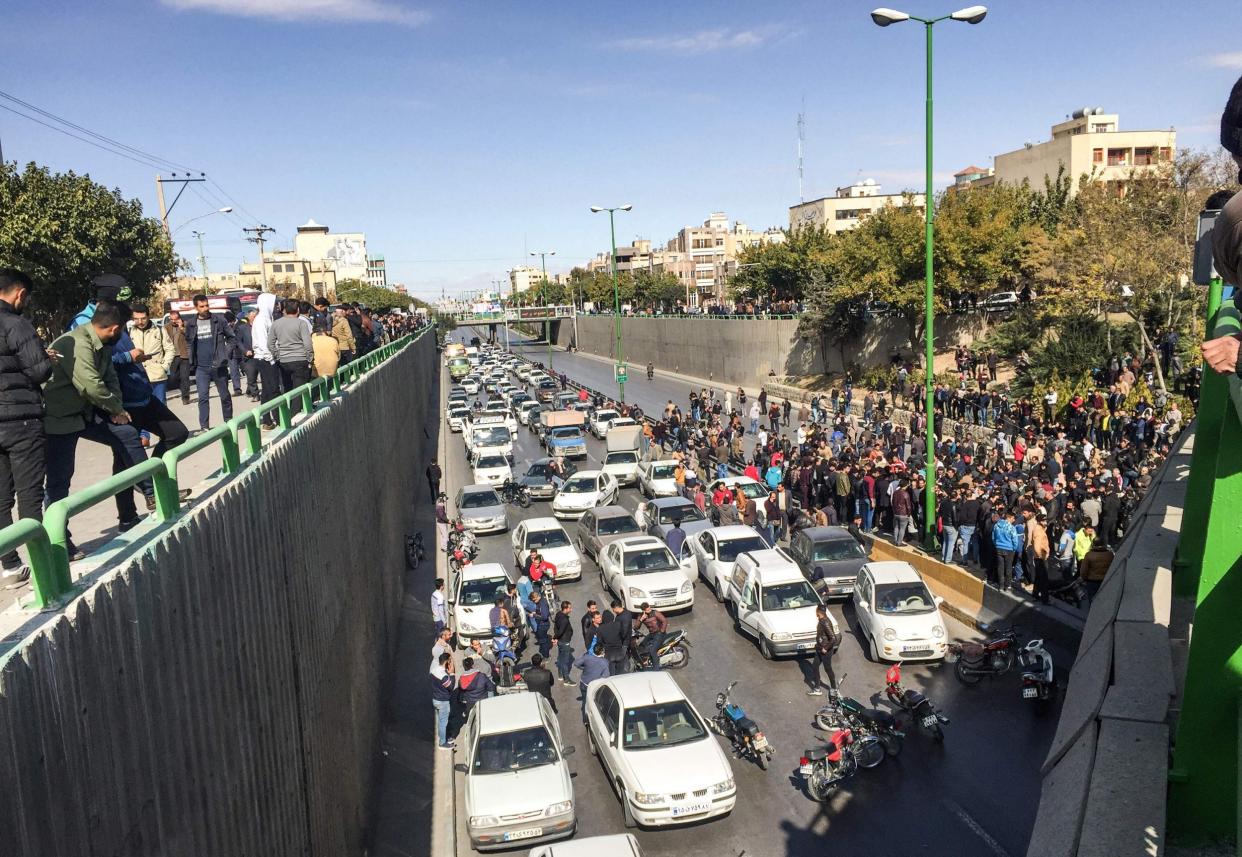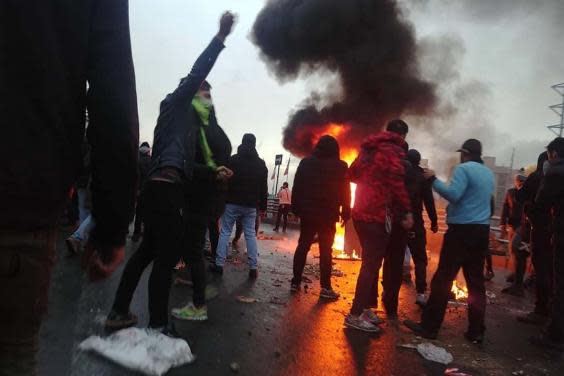Iran protests: How Tehran let a plan to remove subsidies turn into a threat to the regime

The news came late Thursday as the season’s first snowfall began blanketing the northern stretches of the Iranian plateau, and just as tired labourers white-collar employees were arriving home for the weekend after another gruelling work week.
The price of gasoline, Iranian officials announced on broadcast news, would jump 50 per cent for the first 60 litres.
Prices for fuel purchased beyond that amount would cost three times as much, about 70p per litre, which, though a bargain worldwide, is an affront to many Iranians conditioned for decades to consider cheap fuel their birthright.
The price hikes sparked the biggest nationwide protests since a series of demonstrations over economic woes that began in the last days of 2017 and which ran to the middle of 2018.
The latest wave of unrest forced Iranian authorities to cut off the internet, cancel major volleyball, football, wrestling and weightlifting events, and shut down the Grand Bazaar in Tehran, over fears that the country’s traditional merchant class would join in the protests.
At least three people have been killed, including a police officer in the western city of Kermanshah, according to authorities cited by state media.
But unlike last year’s protests, which were concentrated in small, rural outposts, these demonstrations have erupted in the provinces, while simultaneously penetrating deep into the country’s major cities, with the centres of Tehran, Shiraz, Isfahan, and Tabriz all erupting in fiery protests.
One member of parliament, Mohammad Qassim Osmani, resigned his post in protest at the government’s handling of the price increases, while a number have raised concerns that the move was carried out without the input of rank-and-file lawmakers.
And the protests have garnered major international attention, including from Washington.
“The United States supports the Iranian people in their peaceful protests against the regime that is supposed to lead them,” said a statement issued by the White House on Sunday. “We condemn the lethal force and severe communications restrictions used against demonstrators.”
For now it remains uncertain whether the protests will continue amid a heavy crackdown. At least 1,000 people have been arrested, according to state media.
But the coalescing of urban and rural grievances into a movement against the regime could be the formula that triggers the downfall of Iran’s entrenched system.
Sanctions or no sanctions, we need to reform our economic structure
Ali Rabei, presidential spokesperson
That is still a long way off, say Iran watchers. “Without a clear goal and a clear, specific leadership, these things lead to nowhere,” said one Iran analyst who asked not to be named because he travels frequently to Tehran.
Nevertheless, the episode can be seen as a turning point, illustrating the increasing disconnect between the country’s leadership and a population that has borne the brunt of renewed US sanctions under the administration of Donald Trump.
Experts have long warned that ordinary Iranian people and not the leadership would feel the pain of those sanctions.
The thuggish and cult-like paramilitary groups that serve as the regime’s enforcers have access to subsidised goods and perhaps fuel, shielding them from the worst of the economic straits and giving them an incentive to crack down harshly on their countrymen.
“The Revolutionary Guard will firmly deal with the continuation of any kind of insecurity or actions to disrupt the people’s calm and comfort,” said a statement issued on Monday by the Guard, which serves as an ideologically fervent parallel branch of the armed forces.

For a country that has long billed itself as a defender of the oppressed, Iran’s leadership now finds itself siding with those wielding truncheons against ordinary people demanding good government and economic reform in Iraq, Lebanon and in its own land.
“We should not allow insecurity in society,” Iranian president Hassan Rouhani said on Monday. “People have the right to protest but protests are different from riots. I thank the Intelligence Ministry, the police, Revolutionary Guard, the Basij militia and all the armed forces and security forces for their efforts to identify leaders of the people who were after destroying public property.”
Mr Rouhani’s government sought and obtained the approval of the speaker of parliament and the head of the judiciary as well as Supreme Leader Ali Khamenei before announcing the spike in prices, which his administration said would save $7.2 billion per year.
“The government’s revenues have significantly fallen in view of reduction in oil exports,” Rouhani spokesman Ali Rabei said on Monday. “Sanctions or no sanctions, we need to reform our economic structure.”
Mr Rouhani had little choice. Unable to obtain credits internationally and unwilling to lower expenditures by taking on the powerful religious foundations and Revolutionary Guard-linked businesses that suck up resources and pay no taxes, the government was forced to turn to subsidy reform causes sharp immediate pain for ordinary people.
“Instead of cutting their budget costs from some public entities or instead of boosting their budget through semi-public companies who do not pay taxes, they simply charge the budget from people,” said Mahdi Ghodsi, an economist specialising in Iran at the Vienna Institute for International Economic Studies.
“People understand it very well at these times and they perceive that their own government is again pushing the responsibility on them,” he said.
For years the World Bank, United Nations and International Monetary Fund have pushed developing countries to remove subsidies on energy and commodities, policies taken up in recent years in Morocco, Ukraine, India and Egypt. Economists say Iran has some of the highest fossil fuel subsidies in the world, encouraging waste and over-consumption.
The shift away from subsidies allows governments to invest in social services and infrastructure instead, and free up commodities for export, as well as avoid cross-border price differences that encourage smuggling.
Most countries introduce fuel subsidy reforms with advance warning, earning political buy-in by arguing the merits of removing subsidies that encourage waste and environmental degradation.
It was a right step taken at the wrong time and in a very wrong manner
Iran expert
There was little such talk in Iran, no airing of arguments for and against. It also came at a time when Iranians are hard-pressed financially and worried about inflation, which has pauperised the middle class.
In addition, most Iranian cities lack decent public transportation. Even those Iranians who don’t own their own cars rely on sometimes informal networks of drivers to taxi them around cities.
The price hike also came out at a time of maximum political repression of dissidents. Not only have arrests of political activists and harassment of ethnic and religious minorities picked up steam, even the lawyers brave enough to defend them have been jailed.
Instead of social harmony and consensus, the government opted for fear and intimidation.
“The move to increase the petrol prices should have been done,” said the Europe-based Iran expert.
“It was a right step taken at the wrong time and in a very wrong manner,” he said. “The way it was declared was very weird. If there was a kind of public debate there would have been less anger. Now it’s as if the government doesn’t trust the people.”

